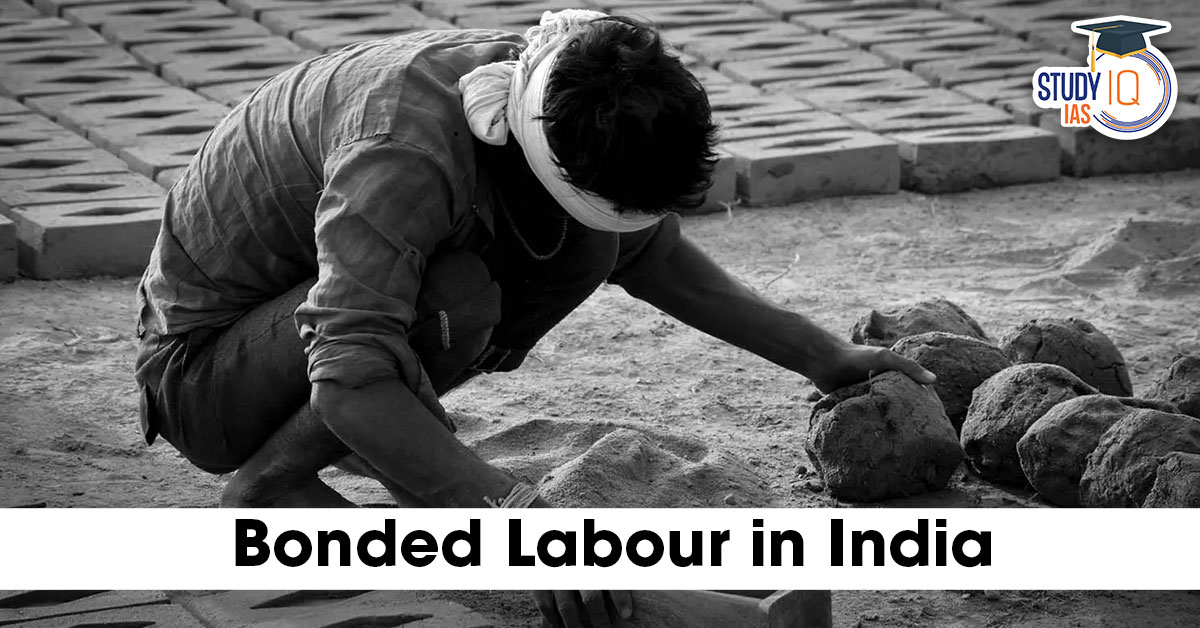Table of Contents
Context: On May 1, while the world celebrates Labour Day to respect workers and their rights, the lives of millions trapped in bonded labour in India show a darker side of reality.
Key Factors Contributing to Bonded Labour in India
- Poverty and Economic Shocks: Sudden financial needs like medical emergencies, dowries, or food shortages force workers to take exploitative loans, pushing them into bondage.
- Eg., A person from Shivpuri (M.P.) took a ₹500 advance and was trafficked 1,400 km to Karnataka, ending up in brutal bonded labour on a sugarcane farm.
- Social Discrimination and Exclusion: Caste, ethnicity, and religious bias deepen marginalisation, increasing vulnerability to exploitation.
- Lack of Education and Awareness: Illiteracy and poor legal literacy prevent workers from understanding their rights or seeking help.
- Informal Employment and Employer Monopolies: In informal sectors, employers dominate local labour and credit markets, using this power to exploit workers.
- Migration and Climate Stress: Migration driven by climate change and rural distress leads to informal, exploitative jobs in urban centres without social security.
Also Read: Central Sector Scheme for Rehabilitation of Bonded Labourer
Impact of Lack of Unionisation on Unorganised Workers
- No Platform for Collective Bargaining: Without trade unions, workers cannot collectively demand fair wages, safe working conditions, or reasonable hours.
- Greater Risk of Exploitation and Abuse: In the absence of union backing, workers are more prone to physical abuse, wage delays, and sudden termination.
- Eg., A family from Andhra Pradesh, trapped in a brick kiln, suffered beatings and verbal abuse, with no one to intervene or advocate for them.
- Low Awareness of Rights and Entitlements: Many workers remain unaware of their legal rights and available welfare schemes due to illiteracy and a lack of representation.
Government Initiatives to Abolish Bonded Labour in India
Bonded Labour System (Abolition) Act, 1976
- Legally abolished the practice of bonded labour in India.
- Declared all bonded debts null and void and mandated the release and rehabilitation of labourers.
Centrally Sponsored Scheme for Rehabilitation of Bonded Labour (1978, revised 2016)
- Provided financial assistance for rehabilitation.
- Revised in 2016 to raise financial assistance to ₹1 lakh–₹3 lakh per person, depending on the severity of exploitation.
Draft National Policy on Rehabilitation of Rescued Bonded Labourers (2016)
- Envisioned a 15-year target (till 2030) to rescue and rehabilitate 1.84 crore bonded labourers.
- Included provisions for temporary shelter, legal aid, and skill development.
Role of Vigilance Committees
Mandated under the 1976 Act to be formed at district and sub-divisional levels for identification, release, and rehabilitation.
Outcomes and Shortfalls
- Poor Implementation and Rescue Rates: Only 12,760 labourers were rescued between 2016–2021, despite a target of 84 crore.
- To meet the goal by 2030, 11 lakh rescues/year were required—clearly unachievable at the current pace.
- Underreporting and Lack of Reliable Data: Many states report zero bonded labourers, despite ground realities contradicting these claims.
- No nationwide database exists to track cases effectively.
- Weak Vigilance Mechanisms: Vigilance committees often exist only on paper or are inactive due to bureaucratic apathy.
- Inadequate Rehabilitation Support: Financial assistance is delayed or denied; rescued workers often relapse into bondage due to a lack of livelihood alternatives.
- Exclusion of Informal Forced Labour: Millions in the informal economy face conditions akin to bondage but are not recognised under current rescue policies.
Way Forward
- Strengthen Rescue Mechanisms: Improve coordination between state and central authorities.
- Extend Social Protection: Provide unorganised workers with insurance, healthcare, and maternity benefits.
- Revive Trade Unionism: Empower informal workers through local unions and legal awareness campaigns.
- Boost Rural Employment: Reduce migration by expanding MGNREGA, rural skilling, and climate-resilient jobs to address the root causes of bondage.
- Data-Driven Policy Action: Update bonded labour estimates and include informal forced labour indicators in national labour statistics.


 Maternity Benefit Act 1961, Applicabilit...
Maternity Benefit Act 1961, Applicabilit...
 Child Labour in India, Causes, Challenge...
Child Labour in India, Causes, Challenge...
 Empowering Women in Agriculture for Food...
Empowering Women in Agriculture for Food...





















